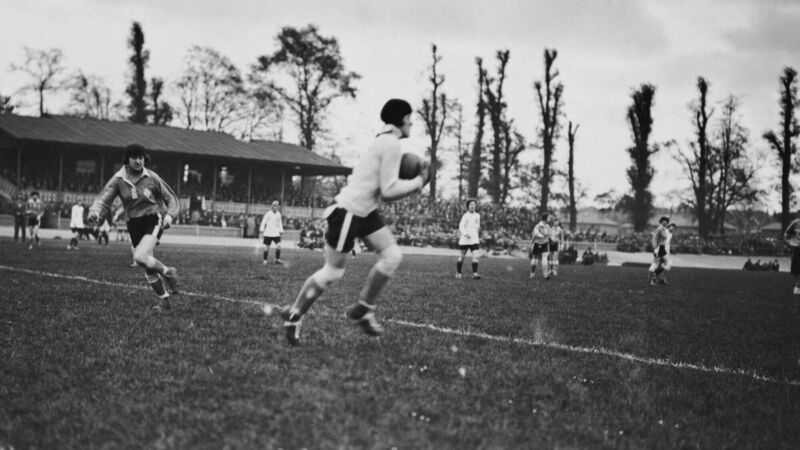Paul Rouse: Even 100 years on, ban on women's soccer a lingering stain on modern world

ACT OF DEFIANCE: The French goalkeeper making a save during a women’s international between the Preston Ladies Football Club (representing England) and France in May 1925. Four years earlier, the FA voiced their ‘strong opinion that the game of football is quite unsuitable for females and ought not to be encouraged’. The reaction of the press at the time suggests broad support for the FA’s stance. Picture: Getty Images
One hundred years ago this month, the Football Association (FA) banned the playing of women’s soccer matches on pitches that were owned by clubs affiliated to the FA.
The de facto impact of that ban was to destroy the potential for the growth of organised women’s soccer in England for most of the remainder of the 20th century.
This had obvious consequences for the prospect of women playing soccer in Ireland. When it comes to the playing of women’s sport in Ireland, it is a simple fact that what happened in England was largely replicated in Ireland.
Only now — in a new millennium — is women’s soccer making significant progress in Ireland and England. The legacy of decades of prohibition (not to mention the rank discrimination that underpinned it) will remain a reality for many more years, however. In everything from media coverage to crowds attending matches to the payment of players and the basic numbers of girls who take up the sport, the impact of the ban that was introduced 100 years ago this month lives on in a very real way.
What is interesting is that back in December 1921 women’s soccer had begun to overcome the barriers that had denied the prospect of it growing alongside the men’s game during the Victorian era when its rules were first written down.
In the ideology of the British Empire, it was through games that boys were made into men. Indeed, sport was perceived as the perfect academy to learn the skills that made life possible in the first instance and then allowed for a successful career to be created.
In short, it was where men learned the virtue of courage, vigour and stamina. The logic of this ideology was that the corollary of men becoming men through sport meant that there was no space for women.
And this was not just a matter of ideology or of cultural preference; it was also presented as being a matter of science.
In the Victorian world, science fed the belief that men and women were complementary opposites. The notion was still current that excessive sporting activity could diminish a woman’s capacity to have children.
Women were considered only to have a fixed amount of energy and wasting it on sporting activity deflected them from fulfilling the roles of wife and mother.
The position of almost all of the men who ran the newly created world of sport was set out with clarity by the founder of the modern Olympic Games, Baron Pierre de Coubertin, who argued in the 1890s that women’s sport was “against the laws of nature”, and that “the eternal role of woman in this world was to be a companion of the male and mother of the family, and she should be educated towards those functions”.
Nonetheless, despite a torrent of abuse and sneering, organised soccer matches between women had taken place in the 1880s and 1890s. In 1894 a British Ladies Football Club was founded and the playing of organised matches drew thousands of spectators.
There is no denying that women’s soccer remained a marginal pursuit, however, at the end of the 19th century and in the first years of the 20th century. The wider societal discrimination against women was not something that any sport could simply live outside.
The dramatic upheaval of World War One changed this — at least to some extent. With millions of men away at war, women began to find roles in workplaces in which they previously were prohibited. These prohibitions extended from the professions (barristers) to middle-class employment (the banks) and all across the industrial sector and its factory floors.
It was now considered vital that women who were working long hours in essential war industries would be provided with outlets for recreation. As it happened, women began to play soccer matches as their recreation of choice. The playing of some such matches became not merely a matter of recreation but also one that became bound into the war effort itself. Large numbers of spectators began coming to the games and these occasions were recast as charity events.
As Lisa Jenkel has written, despite the fact that there were of course still those who considered women’s football to be a travesty of the real thing, the crowds grew and grew and the playing of women’s soccer matches became quite the phenomenon.
It would appear that at its peak there were some 150 teams active across Britain.
This was something that continued after the war for several years.
However, as the men’s game re-asserted itself, a backlash emerged. This backlash was predicated on the idea that soccer was a game for men and the context was the attempt to restore what Jenkel notes as the traditional gender norms that existed pre-war.
As writers such as Fiona Skillen and Jean Williams have shown, opponents of women’s soccer cast it either in a sexualised manner or condemned the women who played the game as unfeminine. Now, again in the 1920s, it was stated that playing soccer could seriously impair the capacity of a woman to fulfil her “duties” as a mother.
Ultimately, this sentiment manifest itself in the declaration by the FA in December 1921 of their “strong opinion that the game of football is quite unsuitable for females and ought not to be encouraged”.
As if to cover their chauvinism in a cloak of righteousness, the FA claimed that their motivation for banning women’s soccer from the grounds of its affiliated clubs was because “an excessive proportion of the receipts are absorbed in expenses and an inadequate percentage devoted to charitable objects”.
There were those who immediately and vehemently opposed the ban. The manager of one hugely successful women’s team at the time pronounced disgust as the taking of such a retrograde step.
But the reaction of the press at the time suggests broader support for the decision of the FA. In this, it is clear that the “soccer ban” was at its core a reflection of wider society.
The subsequent marginalisation of women’s soccer in Britain was a clear consequence of the ban. It says much about the slow pace of social change around ideas of gender that it was not until 1972 that the ban was finally revoked.
A further 50 years have passed since that revocation. The story of these 50 years is the story of painfully slow change and as 2022 dawns it still cannot be claimed that women who wish to play soccer enjoy anything approaching the treatment afforded men at any level of the sport. And that is an enduring stain on the modern sporting world.
- Paul Rouse is professor of history at University College Dublin

Unlimited access. Half the price.
Try unlimited access from only €1.50 a week
Already a subscriber? Sign in








